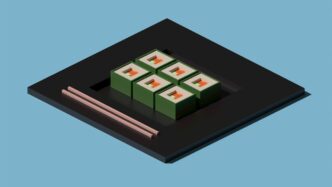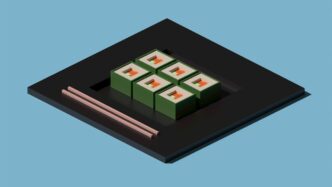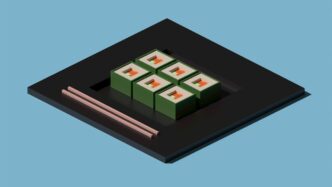OQC’s Ambitious Quantum Computing Trajectory
Oxford Quantum Circuits (OQC) isn’t just tinkering with quantum computers; they’ve laid out a pretty bold plan for where they’re headed, all the way to 2034. It’s not just about building more qubits, but about making them useful. They’re talking about moving beyond the noisy physical qubits we have now and getting to the good stuff: logical qubits. These are the ones that have error correction built-in, making them way more reliable for actual calculations.
Transitioning to the Logical Qubit Era
Right now, a lot of quantum computing feels like trying to build a skyscraper with slightly wobbly bricks. You need a ton of physical qubits to get a few reliable ones. OQC is aiming to change that. Their goal is to get to a point where they need way fewer physical qubits for each logical qubit – think a 10-to-1 ratio instead of the current 100-to-1 or more. This is a big deal because it means we can scale up much faster and more efficiently. They’re focused on making quantum computers that can actually do work, not just sit there and look impressive.
Achieving Practical Quantum Advantage by 2028
By 2028, OQC wants to hit a major milestone: practical quantum advantage. This means having a quantum computer that can solve a real-world problem faster or better than any classical computer could. They’re targeting specific areas where this could happen:
- Fraud Detection: Spotting suspicious transactions or patterns that are too complex for current systems.
- Cyber Threat Analysis: Identifying sophisticated cyberattacks by analyzing vast amounts of network data.
This isn’t just theoretical; they’re building systems designed for these kinds of tasks, aiming for around 200 logical qubits by this date. It’s about getting quantum computing out of the lab and into practical use cases.
Scaling to 50,000 Logical Qubits by 2034
Looking further out, the 2034 target is pretty mind-blowing: 50,000 logical qubits. If they pull this off, the kinds of problems we can tackle expand dramatically. We’re talking about:
- Drug Discovery: Simulating molecules to find new medicines much faster.
- Materials Science: Designing new materials with specific properties from scratch.
- Financial Modelling: Running incredibly complex simulations for risk assessment and investment strategies.
This massive scaling is what will truly unlock the transformative potential of quantum computing across many industries.
OQC’s Technological Innovations

Oxford Quantum Circuits (OQC) isn’t just talking about the future of quantum computing; they’re building it with some pretty neat tech. Their whole approach is built around making quantum computers more practical and powerful, and a lot of that comes down to their hardware.
Patented Three-Dimensional Coaxmon Architecture
One of the standout things OQC has developed is their patented three-dimensional Coaxmon architecture. Think of it as a new way to arrange the components inside a quantum computer. This design is a big deal because it’s engineered to be more scalable than older methods. It helps pack more qubits into a smaller space and makes them easier to connect and control, which is a major hurdle in building bigger quantum machines.
High-Fidelity Qubits and Advanced Error Correction
Getting qubits to work reliably is tough. Errors happen all the time in quantum systems. OQC is focusing hard on two key areas to combat this: high-fidelity qubits and advanced error correction. High-fidelity means the qubits themselves are very accurate and stable, minimizing mistakes from the start. They’ve shown gate fidelities of 99.8%, which is really good, and they can do it fast – in about 25 nanoseconds. On top of that, they’re developing smart ways to correct errors that do pop up. This combination is what allows them to build more robust quantum systems.
Efficient Physical-to-Logical Qubit Ratio
This is where OQC is really trying to change the game. Right now, you often need a lot of physical qubits just to make one reliable ‘logical’ qubit (the kind that does the actual computing). OQC’s architecture and error correction methods are designed to drastically cut down on this overhead. They’re aiming for a ratio where maybe 10 physical qubits are needed for one logical qubit, a big improvement over the 100 or more that some other systems might need. This efficiency is key to reaching those large numbers of logical qubits they’re aiming for by 2034.
Application-Optimised Compute Strategy
So, OQC isn’t just building a bigger quantum computer; they’re building the right kind of quantum computer for specific jobs. This is what they call ‘Application-Optimised Compute’. Instead of trying to make one machine do everything, they’re engineering systems to tackle particular problems where quantum computers can actually beat regular computers. It’s like having a specialized tool for a specialized task, rather than a general-purpose hammer that’s okay at everything but great at nothing.
Tailoring Systems for Specific Computational Challenges
This approach means OQC is working closely with potential users to figure out what problems are the biggest headaches right now. They’re not just waiting for algorithms to appear; they’re actively designing hardware and software together, making sure they fit like a glove for certain types of calculations. This co-design process is supposed to speed things up and make the quantum computers more effective from the get-go. The goal is to solve problems that are just too hard or take too long on today’s best supercomputers.
Focus on Fraud Detection and Cyber Threat Analysis
By 2028, OQC is aiming to have systems ready that can make a real difference in areas like spotting financial fraud and figuring out cyber threats. These are complex problems that involve sifting through massive amounts of data and looking for subtle patterns. A quantum computer, tailored for this, could potentially identify suspicious activity much faster and more accurately than current methods. Think about it: spotting a sophisticated cyber attack in real-time or catching a complex fraud scheme before it causes major damage. That’s the kind of impact they’re talking about.
Transformative Potential in Financial Services and Security
Looking further ahead, especially as they scale up to thousands of logical qubits, the possibilities really open up. For financial services, this could mean much better ways to manage investments, assess risk across huge portfolios, and run complex simulations to predict market behavior. In security, beyond cyber threats, it could extend to things like code-breaking or developing new encryption methods. It’s about having a computational tool that can explore a vast number of possibilities simultaneously, which is something classical computers struggle with. This could fundamentally change how these sectors operate.
OQC’s Market Leadership and Deployment
First European Quantum Computer on Amazon Cloud
So, OQC has been busy making waves, and one of the big splashes was putting their quantum computer on Amazon’s cloud. This is a pretty big deal because it means people outside of OQC’s own labs can actually get their hands on this advanced tech. It’s like when a new gaming console comes out, and suddenly everyone can play the latest games, not just the developers. This move makes OQC the first European company to offer its quantum computer through a major cloud provider like Amazon Web Services. It really opens the door for more businesses and researchers to explore what quantum computing can do, without needing to build their own super-expensive machines.
Deployment into Commercial Data Centers
But they didn’t stop there. OQC also went ahead and put a quantum computer right into a regular, commercial data center. Think of it like setting up a specialized, super-powerful server farm, but for quantum stuff, mixed in with all the other computers. This is pretty groundbreaking because it shows that quantum computers don’t necessarily need their own isolated, super-clean rooms. They can actually start to integrate into the existing tech infrastructure we already use. This makes it way easier for companies to access quantum power when they need it, fitting it into their current IT setup.
Quantum Computing as a Service (QCaaS) Model
All of this points to OQC really pushing the ‘Quantum Computing as a Service’ model. Basically, instead of buying a whole quantum computer – which is, you know, astronomically expensive and complicated – you can just rent time on one. It’s similar to how we use cloud storage or software subscriptions now. This approach has a few key benefits:
- Accessibility: More people and companies can try out quantum computing.
- Cost-Effectiveness: You pay for what you use, avoiding massive upfront costs.
- Flexibility: You can scale your usage up or down as needed.
- Focus on Problems: Companies can concentrate on solving their specific challenges using quantum power, rather than worrying about managing the hardware itself.
This QCaaS strategy is OQC’s way of making quantum computing practical and available to a wider audience, moving it from a futuristic concept to a usable tool for businesses today.
Future Applications and Sectoral Impact
Advancements in Drug Discovery and Quantum Chemistry
So, what does all this quantum power mean for, say, finding new medicines? Well, it’s pretty big. Right now, figuring out how molecules interact is super complex and takes ages on even the best regular computers. Quantum computers, especially with OQC’s roadmap, could change that. We’re talking about simulating chemical reactions with incredible detail. This means scientists could design new drugs much faster, predicting how they’ll work in the body before even making a physical sample. It’s like having a crystal ball for chemistry, speeding up the whole process from lab bench to patient.
Complex Simulations in Materials Science
Beyond medicine, think about materials. We could be looking at designing entirely new substances with specific properties. Imagine creating lighter, stronger materials for planes or cars, or developing better catalysts for industrial processes. Quantum computers can model the behavior of atoms and electrons in ways that are just impossible today. This could lead to breakthroughs in everything from renewable energy technology to advanced electronics. It’s a whole new frontier for engineering.
Enhanced Financial Modelling and Risk Assessment
And then there’s the world of finance. The financial sector deals with a ton of data and complex variables. Quantum computing could help by running much more sophisticated models. This means better ways to predict market movements, manage investment portfolios, and assess risk. The ability to explore a vast number of scenarios simultaneously could lead to more stable and efficient financial systems. It’s not just about making more money; it’s about understanding and managing the risks involved with a level of precision we haven’t seen before.
Looking Ahead
So, Oxford Quantum Circuits is really laying out a big plan, aiming for some serious quantum computing power by 2034. It’s a bold move, especially with their focus on logical qubits and making these machines more practical for real-world problems like spotting fraud or analyzing security threats. They’re not just talking about it; they’ve got the tech, like their special Coaxmon design and those impressive gate speeds, to back it up. It’ll be interesting to see how they actually get there, but their roadmap definitely puts them on the map as a company to watch in the quantum race. It feels like we’re getting closer to the point where quantum computers won’t just be lab experiments anymore.














